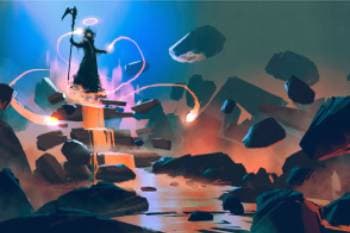Are Books Considered Art?
As an avid reader, you already know how important books are. They give you hours of entertainment, help you explore new worlds without leaving home, and serve as an essential source of information. But can they be considered art?
Books are considered art. All parts of a book are art, from writing, typesetting, and bookbinding to cover design and the act of reading a book. Books are made possible due to numerous interconnected art forms, so the final product can also be considered art.
If you have never thought of books as art, this can be a surprising idea. This article will look at all the ways in which a book is art—and we hope that, once you reach the end of this piece, you’ll also agree with us.

This blog post contains affiliate links
Writing Is an Art Form
According to the Oxford English Dictionary, art is defined as “the application of skill to subjects of taste, as poetry, music, dancing, the drama, oratory, literary composition, and the like.” As you can see, literary composition, or writing, is one of the arts.
Art is, essentially, the use of skill, creativity, and imagination in crafting something. Fiction writers use these elements to bring new worlds to life with their words—but fiction is not the only type of writing that can be considered art.
Even non-fiction writing can be considered an art form when creatively written. Creative non-fiction is a writing style that employs the use of literary styles and techniques such as metaphors to create a narrative. If you ever try to write an autobiography, you’ll quickly realize that writing non-fiction involves more than simply knowing the facts inside and out. While writing is easy, writing well is another question altogether.
The one form of writing many do not consider art is technical writing. However, even technical books often involve some type of art, whether in their cover design, bookbinding, or other elements.
Typesetting and Book Binding Is More Than Just a Technical Part of Publishing
When people think about typesetting and bookbinding, they usually don’t give them much thought beyond thinking of these two tasks as technical aspects of publication. However, they can often be art forms in themselves.
For example, consider typesetting. When it was done by hand, it was easy to understand why it was art. However, now that it’s all done by machines, it shouldn’t be an issue, right?
Wrong. Typesetting generally involves the intervention of a human typesetter to ensure the alignment is correct. Additionally, these typesetters often pick the fonts for published works themselves. This doesn’t just cover the primary font that much of the book is in, it also covers any “additional” fonts that are used to highlight words and phrases or to denote in-book forms of media.
In some books, typesetting is taken to the extreme. Consider the well-known book House of Leaves (available on Amazon). If you’ve ever read it—or even seen some of its pages—you’ll quickly understand why its typesetting is extraordinary. The format of the book reflects the labyrinthine house featured in the story, and the typesetting helps enhance the effect significantly.
Similarly, bookbinding is also an art. Hand binding a book often involves a significant amount of sewing, and expert bookbinders can hide an enormous amount of detail with the binding of a book. Everything from choosing the materials to actually working on the binding takes considerable care, and the difference in quality between a hand-bound book and a machine-bound one is immediately apparent.
Cover Art Requires an In-Depth Understanding of Art
You’ve probably heard the saying, “don’t judge a book by its cover.” However, the reality is that most of us do refer to a book cover (and the blurb) to determine which book is worth reading. Given how critical the cover is in ensuring a book is successful, it’s easy to understand why cover artists are vital to book publishing.
A cover artist must understand the book they are working on thoroughly. The image on the cover serves as a way to tell the story within the book’s pages in a single snapshot, and creating such an image isn’t possible if you don’t understand the book, to begin with.
Once the cover art is created, it is sent to a cover designer. These designers ensure you get the full impact of the image on the cover while also adjusting the design to incorporate the book’s title, the author’s name, and other elements that make up the book’s cover.
Both creating cover art and designing the cover are art forms. It’s easy to understand how the cover art is art—cover designers need to understand proportion and form to adjust the cover art so that it doesn’t lose its appeal while still ensuring all the relevant details are present on the cover.
Reding a Book Is an Art Form
A book does not stop being art once it reaches your hands. In fact, reading a book can be considered an art form in itself.
Readers, in many ways, write the books they read along with the authors. It is our imaginations that fill in the many gaps in the narrative, and we work to imagine what characters look like, filling in the details beyond what is described in the book.
For example, most of us have a mental image of how tall the main Harry Potter characters are, even though their heights are not always well described in the books.
Additionally, readers often critique the books they read, for the good and the bad. This requires the reader to have not only an in-depth understanding of the book but also the ability to enunciate your thoughts.
W.H. Auden, among the best-known British poets, wrote extensively about how reading was an art. Readers, he said, interpret books in different ways than their authors would. According to him, the best readers learn to interpret books well, and this ability to interpret books is an art in itself.
Additionally, readers have to be able to distinguish which books they love and what topics they enjoy. Understanding what we like and love to read is an art form in itself, and it not only helps make reading more enjoyable but also helps readers understand themselves better.
Final Thoughts
Every element of the book in your hands is art—up to and including your reading of them. Depending on the genre and the publishing plan, a book may also include illustrations and designs incorporated into chapter headings.
Given this reality, it’s clear why books are considered art.






